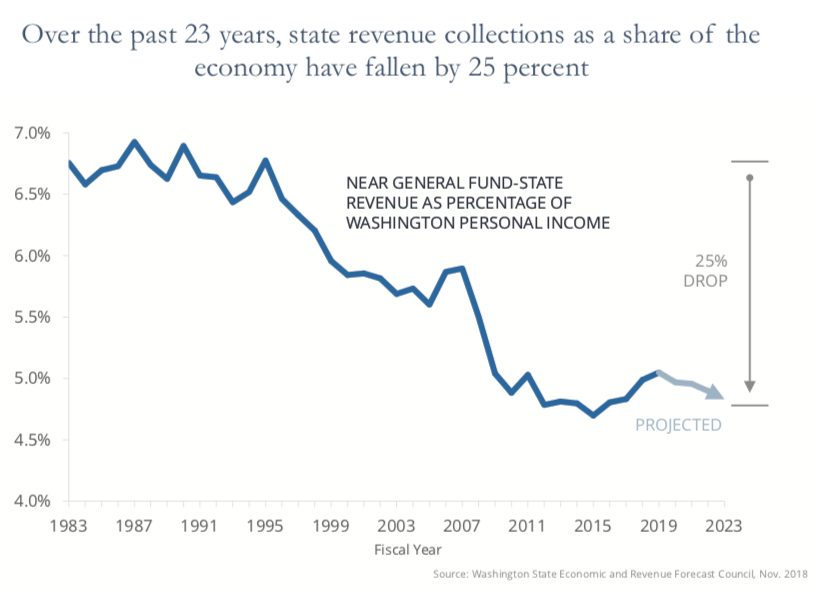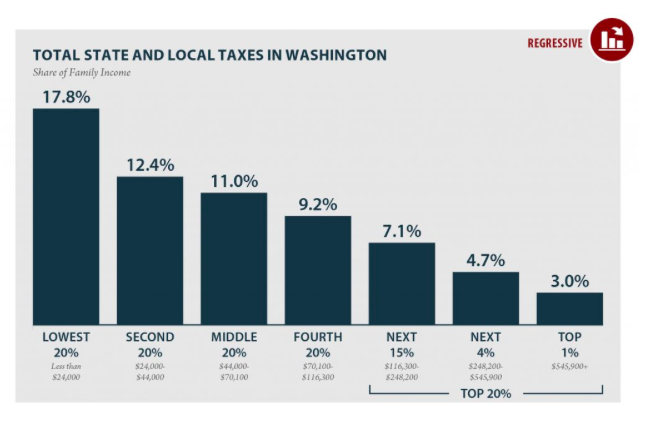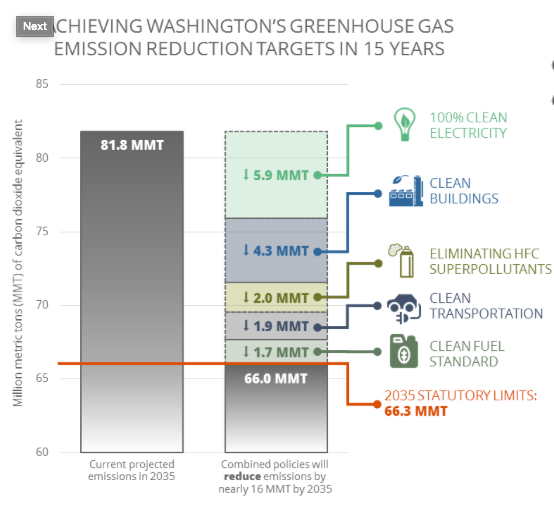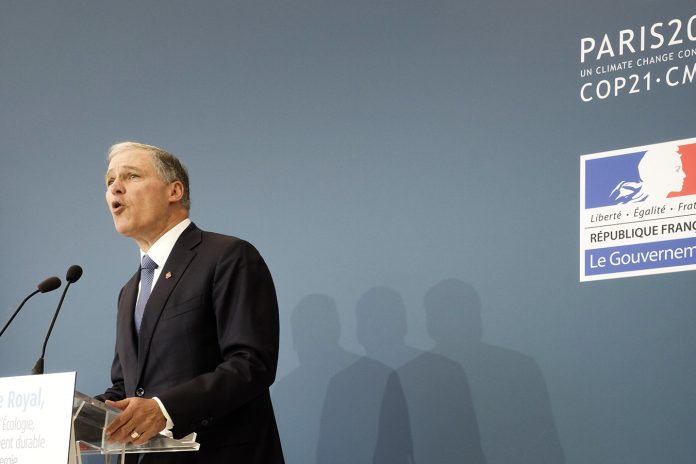New taxes would create $3.7 billion in revenue, helping to fund investments in cleaner buildings and electric powered transportation.
Last week Governor Jay Inslee’s proposed 2019-2021 budget was released. With Washington Democrats having taken the majority in both that state house and senate for the first time since 2013, advocates were hoping that the legislature would take action on carbon emission reductions, although the I-1631 carbon fee initiative’s failure muddied the political waters.
Now the new intended path forward is clearer. The Governor’s proposed $54.4 billion budget contains $273 million that has been targeted toward programs aimed at reducing greenhouse gas emissions.
While it represents only a small portion of the overall budget, climate action advocates are nonetheless pleased to see these investments on the agenda.
“We are very glad to see the governor is stepping up and putting forth a package,” David Perk of 350Seattle said. “Action on climate is decades overdue. The legislature has failed in the past to step up and do what’s needed.”
The proposed budget is about 20% higher than the current budget, and investments in environmental priorities represent some of the increase in the budget. To pay for the larger budget, Governor Inslee has proposed changes to the tax system including:
- A new capital gains tax on the sale of stocks, bonds, and other assets. The 9% tax would apply to capital gains earnings above $25,000 for individuals and $50,000 for joint filers. It is projected that the tax would only affect a tiny fraction of high earning taxpayers–about 1.5% of households in the first year. The capital gains tax would raise an estimated $975 million in fiscal year 2021.
- An increase the state business and occupation tax on services and other activities that would generate about $2.6 billion in the next two year period. Since 1974, services as a share of Washington’s economy have more than doubled, but the current tax system relies more collecting revenue through retail sales taxes on goods.
- Changes to the the state’s real estate excise tax from a flat rate to a graduated rate in which higher value properties would be taxed at a higher rate than lower value ones. The graduated rate would increase state real estate excise tax collections by about $400 million in the next two year period. This money has been designated to pay for the court-ordered removal of fish barriers to help restore salmon runs.
As a whole, these proposed changes are intended to help correct the state’s revenue-starved tax system. Even though Washington is in one of the longest-ever stretches of continuous economic growth, state and local governments still struggle to find enough revenue to sustain their budgets. Washington also continues to have most regressive tax system in the country. The proposed changes are intended to raise much needed revenue in a less regressive manner.


Meeting the State’s Carbon Emission Reduction Goals
One of the primary goals of the current proposal is to finally put Washington on track toward meeting the carbon emission reduction goals it committed to back in 2008, which included reducing carbon emissions to 1990 levels by 2020, to 25% below 1990 levels by 2035, and to 50% below 1990 levels by 2050.
The budget proposal includes five key areas of investment that target reducing carbon emissions, including:
- 100% Clean Energy: Invests in the Clean Energy Fund for projects related to grid modernization and development of clean energy technology, and renewed funding for the state’s solar incentive program.
- Cleaner Buildings: Encourages retrofitting of commercial buildings and modernization of codes for new construction. Also creates a new efficiency standard for natural gas to ensure gas utilities achieve the same conservation savings required for electricity.
- Eliminating HFC Super Pollutants: Phases down the use of hydrofluorocarbons or “super pollutants,” greenhouse gases that can be thousands of times more damaging to the climate than carbon dioxide, replacing them with climate-safe alternatives.
- Clean Fuels: Enacts a clean fuel standard that would require fuel providers to reduce the carbon intensity of fuels. A clean fuel standard is a market-based approach used by Oregon, California and the province of British Columbia to cut greenhouse gas emissions from transportation fuels.
- Clean Transportation: Promotes electric powered transportation through investments in electric ferries, charging stations for electric vehicles, funding for the continued study for ultra high-speed rail connecting Washington to Oregon and British Columbia.
All together, these investments would put Washington on course to meet its goals for 2035, the Governor’s office said.

Unfortunately, even the budget proposal brief admits that the “latest scientific assessments suggest we must reduce emissions even further,” a stance that is supported by the Washington State Department of Ecology and carbon reduction advocates.
“That standard is a decade old and was probably inadequate when it was put in place,” Perk said. “We need standards that are based on current best science.”
The latest budget proposal does contain funds to improve the quality and accuracy of greenhouse gas emission reporting.
What More Needs to Be Done to Combat Climate Change?
Perk and other 350Seattle staff are still reviewing the proposed budget, but so far Perk is excited about the investments in clean buildings. The building sector is a major contributor of greenhouse emissions in Washington, over 27% of overall greenhouse gas emissions can be traced back to buildings.
In regards to clean energy, Perk hopes that Governor Inslee’s efforts can be accomplished ahead of the 2035 targets. “Washington already has so much hydropower. Switching off coal fired power plants and preventing them with being replaced with gas is something we can accomplish by 2030 or even sometime sooner,” said Perk.
One of the 350Seattle’s current legislative priorities is having Washington state not just phase out gas-based cars, but adopt a particular date for the “end of internal combustion vehicles.”
More than nine countries and a dozen cities or states have announced bans on diesel and internal combustion engine vehicles in the last few years. Among the boldest pledges is Norway’s plan to phase out conventional cars by 2025.
Perk, like some economists, believes that adopting a definitive end to the internal combustion vehicles would bring certainty in market place. “It would also be complimentary to the proposed clean fuel standard,” he said.
It is possible such a proposed policy will appear in the next legislative session, although at this time no representatives or senators have declared formal intentions to do so.
350Seattle expects that the next session will be packed with proposed legislation related to climate change. Keeping up with the details of all of the proposals can be a challenge, so they are seeking volunteers to assist with reading through bills. Readers who are interested in this volunteer opportunity, or other ways to engage with 350Seattle’s efforts, can check out their volunteer page for more details on how to get involved.
350Seattle and The Urbanist are both members of the MASS Coalition. The featured image of Governor Inslee is credited to COP Paris and used via Creative Commons.
Natalie Bicknell Argerious (she/her) is a reporter and podcast host at The Urbanist. She previously served as managing editor. A passionate urban explorer since childhood, she loves learning how to make cities more inclusive, vibrant, and environmentally resilient. You can often find her wandering around Seattle's Central District and Capitol Hill with her dogs and cat. Email her at natalie [at] theurbanist [dot] org.



